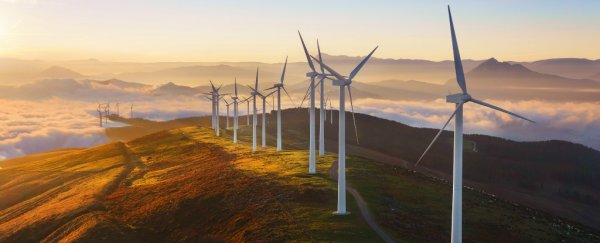Wind energy is a deeply underrated resource. Though the US invested $14.5 billion in wind-power projects last year, wind farms still provide just 4 percent of the nation's electricity, according to the American Wind Energy Association (AWEA).
Globally, that percentage is about the same - Harvard researchers estimate that non-urban wind farms have the technical potential to produce up to 40 times the electricity the world consumes. What would a world powered by wind actually look like?
Steve Sawyer the Global Wind Energy Council's Secretary General, did the maths: 21,000 terawatt-hours (the average annual global electricity consumption) divided by 0.005256 terawatt-hours of annual wind energy production per wind turbine equals approximately 3,995,434 onshore turbines.
In terms of land use, those 3,995,434 turbines would take up about half the size of Alaska if they were spaced close together, Sawyer says.
Wind projects around the world have different space ratios depending on the location, requiring anywhere from 0.04 square miles (1 square km) per megawatt (MW) produced to 0.02 square miles (0.5 square km) per MW produced.
If the turbines were spaced farther apart, 3.9 million turbines would use a land mass that's a little smaller than Spain.
To make his calculation, Sawyer considered that the average wind turbine has an output of 2 MW of power and is 30 percent efficient globally.
That means it can reach its full power-generating potential 30 percent of the time, since wind is not always blowing and wind farms sometimes shut down for routine maintenance.
That percentage also accounts for constraints in the electrical grid - if a grid receives more power from a wind farm than it can handle, for example, managers will turn off a few turbines.
As AWEA's John Hensley previously noted, 30 percent is actually pretty efficient. For comparison, solar projects operate at an average of 20 percent efficiency, and fossil-fuel production facilities operate at 40 percent to 60 percent of their full capacity on average.
When you multiply a wind turbine's average potential (2 MW) by 30 percent annual energy efficiency and 8,760 hours in a year, you get Sawyer's estimate of the annual megawatt-hours of energy production each turbine can produce (5,265 megawatt-hours or 0.005265 terawatt-hours).
Depending on the size of the turbine (larger ones can produce more electricity), we might need fewer wind turbines overall.
If we only used extremely efficient turbines (i.e. ones that create 4 MW of power at 40 percent capacity), about 1.49 million turbines could supply the world's electricity consumption.
Thanks to advancements in wind turbine technology, the cost of deploying wind energy has fallen by 90 percent since the 1980s.
Wind turbines can also now be built taller and larger than ever, allowing them to harness more power than in years past, Hensley says.
Offshore wind farms, in which turbines are installed in the ocean rather than on land, can offer three times the amount of power compared to onshore turbines, since there is more wind blowing over the sea than on land.
Coming to a global consensus that the world should install millions of turbines would be a far-fetched project, even with recent cost reductions.
But becoming less dependent on fossil fuels is always a worthy goal.
This article was originally published by Business Insider.
